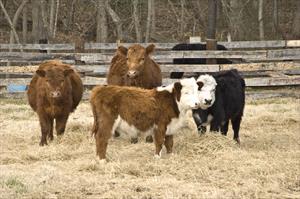Veterinarians who are association members have until Jan. 28 to comment
Beef cattle - USDA APHIS

U.S. Department of Agriculture photo
Ten to 15% of U.S. veterinarians are involved in supporting the health and welfare of animals raised for food, the American Veterinary Medical Association estimates.
With the public more interested than ever in the quality of life of animals raised for food, "careful attention to empirical issues is essential" when considering the ethics of farming and slaughter methods.
That's according to a 31-member panel of veterinarians, scientists and ethicists who spent nearly two years updating the American Veterinary Medical Association's Guidelines for the Humane Slaughter of Animals, a document designed to guide veterinarians in minimizing pain and distress in animals designated for slaughter.
"A range of factors, including expanded knowledge about the cognitive capabilities of animals, technological and economic conditions, and social and ethical considerations affecting the sustainability of animal agriculture, the care and management of food animals, and food security, will influence the recommendations of this, and future editions of this document," the draft guidance begins. (The draft is accessible to AVMA members only.)
Along with stressing that "no unnecessary pain, injury or distress" should be inflicted on conscious animals, the draft guidelines provide updated information about applicable federal statutes and regulations. The revisions also broaden the document's scope via a handful of additions:
- a section on religious (non-stun) slaughter practices (kosher and halal);
- a category on fur bearers, which include mink, fox and rabbit;
- expanded species sections on aquatics, bovids, equids, poultry and small ruminants;
- new references across sections for all species.
While the AVMA Panel on Humane Slaughter is motivated by science and animal welfare ethics, the document says, panelists also were sensitive to agriculture industry concerns that include, among others, public health and safety, food safety and quality, environment and economic sustainability, climate change, production adequacy, occupational health and labor, trade standards and evolving dietary preferences.
However, those issues are not the focus of the guidance, the draft document reads. "The veterinarian's primary responsibility of doing what is in the animal's best interest under the circumstances (i.e., using the most appropriate and painless slaughter method possible and considering the context of the animal's welfare in the United States) should not be displaced by quality, quantity or economic arguments."
The AVMA is soliciting feedback on the draft from its members. Comments must be submitted by Jan. 28.
The AVMA has produced guidelines for veterinarians overseeing the death of animals since 1963, when it convened the first Panel on Euthanasia. In 2011, the panel determined there was a need to address and evaluate methods for humanely slaughtering food animals.
The first edition of the Guidelines for the Human Slaughter of Animals was published in 2016. It is part of a triad of humane endings guidance documents produced by the AVMA. The others are Guidelines for the Euthanasia of Animals and Guidelines for the Depopulation of Animals.
In January, the AVMA Panel on Depopulation is expected to begin formal meetings to review the association's depopulation guidelines for potential updates to the 2019 document. The review will include data on the use of ventilation shutdown plus heat. Also known as VSD+, the method is highly controversial and typically reserved for culling large numbers of livestock, usually swine and fowl, as a last resort in emergency situations.